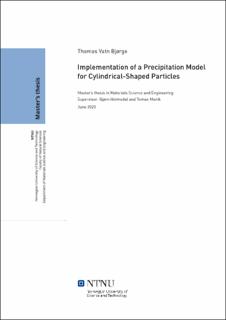| dc.contributor.advisor | Holmedal, Bjørn | |
| dc.contributor.advisor | Manik, Tomas | |
| dc.contributor.author | Bjørge, Thomas Vatn | |
| dc.date.accessioned | 2023-05-15T17:20:54Z | |
| dc.date.available | 2023-05-15T17:20:54Z | |
| dc.date.issued | 2020 | |
| dc.identifier | no.ntnu:inspera:59547306:18591914 | |
| dc.identifier.uri | https://hdl.handle.net/11250/3068053 | |
| dc.description.abstract | I de fleste utherdbare legeringer oppstår det partikler av sekundærfaser som ofte er av ikke sfærisk karakter. I Kampmann Wagner Numerical (KWN) modeller som brukes for å forutse partikkeldistribusjoner, er partiklene antatt å være sfæriske. I denne avhandlingen blir et rammeverk for å modellere de koblede prosessene nukleasjon, vekst og forgroving for sylinder-formede partikler utviklet. Ved å bruke en Lagrange tilnærming kan man diskretisere partikkeldistribusjonen i flere partikkelklasser hvor hver klasse inneholder et antall partikler med identisk størrelse. Videre blir det gjort en differensiering mellom ende- og sideflater for den sylindriske partikkelen med tanke på grenseflatekonsentrasjon og veksthastighetene til de respektive overflatene. Dette er mulig ved å løse diffusjonsproblemet rundt en sylindrisk partikkel for å finne strømmen av atomer inn gjennom de respektive overflatene. I tillegg blir den aksesymmetriske Gibbs-Thomson effekten utledet for ende- og sideflater. Evolusjonen av hver partikkelklasse gjennom tid blir deretter fulgt ved hjelp av en ordinær differensialligningløser og en massebalanse for å holde rede på hvor mye oppløste atomer det er i matrix.
Ved å innføre en funksjon for endeflateenergien som er avhengig av radiusen til partikkelen, er den foreslåtte KWN-modellen i stand til å utvikle forlengete nåler som har en økende aspekt rate gjennom tidsforløpet. | |
| dc.description.abstract | In most age-hardenable alloys, the precipitation of second-phase particles is often of a non-spherical configuration. However, in Kampmann Wagner Numerical (KWN) models for predicting the particle size distribution, the particles are assumed to be spherical. In this thesis, a framework for modeling the coupled nucleation, growth, and coarsening of cylindrical-shaped particles was implemented. Using a Lagrangian approach, the particle size distribution was discretized into several particle classes where each class contained a number of particles with identical size. Further, a distinction between the cylindrical particle's end and side surface were made in terms of interfacial compositions and growth rates of the respective surfaces. This was achieved by solving the diffusion problem around the cylindrical particle to find the solute current into the respective surfaces. In addition, the axisymmetric Gibbs-Thomson effect was derived for the end and side surfaces of the particle. The evolution of each particle class was then tracked through time by the use of an ODE-solver and a mass balance equation to keep track of the amount of solute atoms in the matrix.
By implementing a function for the surface energy of the end surfaces that is dependent on the radius of the particle, the proposed KWN-model was successful in attaining elongated needles that achieve increasing aspect ratios throughout the time evolution. | |
| dc.language | eng | |
| dc.publisher | NTNU | |
| dc.title | Implementation of a Precipitation Model for Cylindrical-Shaped Particles | |
| dc.type | Master thesis | |
